Atomic Habits by James Clear was an absolute game-changer of a book for me. It’s a book I recommend people read so often I thought it was time to create a summary.
I enjoyed the book so much that I’ve actually listened to it on Audible twice and read the book!
I love Audible and I’ll always have it on in the background when I’m doing mundane chores or driving or walking my dog. It’s a great way to learn something new whilst also doing those boring, everyday tasks you’ve got to do!
A friend then bought the book for my birthday and I found myself absorbing it in a whole new way.
I even went through the book and highlighted interesting quotes and sections – something I haven’t done since I was in university many moons ago! I just feel like there are so many incredible nuggets of advice that could have such a huge impact on your life.
About James Clear
James Clear is an American author, best known for writing about self-improvement. As well as writing Atomic Habits, he also writes a popular ‘3-2-1- Newsletter’ which has grown to become one of the most popular newsletters in the world! (I’ve just signed up to it so I’ll let you know how I get on with it!) It goes out to over 1 million people and you can read all the past issues here.
They are short, thought-provoking newsletters with quotes and questions encouraging you to improve your life in simple ways.
Atomic Habits Summary
Atomic Habits is a personal development book by James Clear. It’s about simple rules that will help you develop good habits and stop bad habits. The book has sold over 5 million copies worldwide and is described as ‘life changing’ by many people. Including me!
I read lots of personal development books and Atomic Habits is the best I’ve ever read.
The book is easy and enjoyable to read. There’s no technical jargon in there and it’s broken up into small sections, making it easy to digest and it feels like a quick read.
If you prefer concise takeaways, this summary of Atomic Habits offers all the key insights in a streamlined, accessible format—perfect for readers who appreciate quick, practical reads.
Lots of the tips are the type that are so simple and obvious that they’re often overlooked.
Some were things I’d never considered and many were things I already did but it wasn’t until it was highlighted to me that I realised the power of them. I realised I had lots of unconscious habits and becoming conscious of them enabled me to harness the power of them and apply them to other things.
All of the tips in the book are backed up with scientific research and real-life stories which makes it relatable and easier to remember.
My key takeaway from Atomic Habits – ‘Tiny Changes, Remarkable Results’
The main thing I took away from Atomic Habits was that little things lead to big results.
The tagline of the book is:
‘Tiny Changes, Remarkable Results’
And it’s so true.
I’m more of a ‘Go Big or Go Home’ kind of person.
When I start something new I like to throw everything into it and give it everything I’ve got. I love the excitement and energy of a new project but I struggle to keep up that momentum for long so I burn out after a few days.
I start big…and then I go home! I’ve never liked the idea of ‘little and often’. It’s always felt a bit pointless and like it wouldn’t lead to big results.
I like instant results and like to see my hard work paying off immediately.
That’s why I like blogging. I write a blog post, hit publish and then I immediately see people reading it. I get instant gratification in the form of pageviews, comments and emails!
I don’t like the idea of doing a little bit each day for years and years and years. I want to do it all right now.
But if I took just one thing from this book, it’s the fact that ‘little and often’ has a much bigger impact on your life.
“It is so easy to overestimate the importance of one defining moment and underestimate the value of making small improvements on a daily basis. Too often, we convince ourselves that massive success requires massive action…. We put pressure on ourselves to make some earth-shattering improvement…’
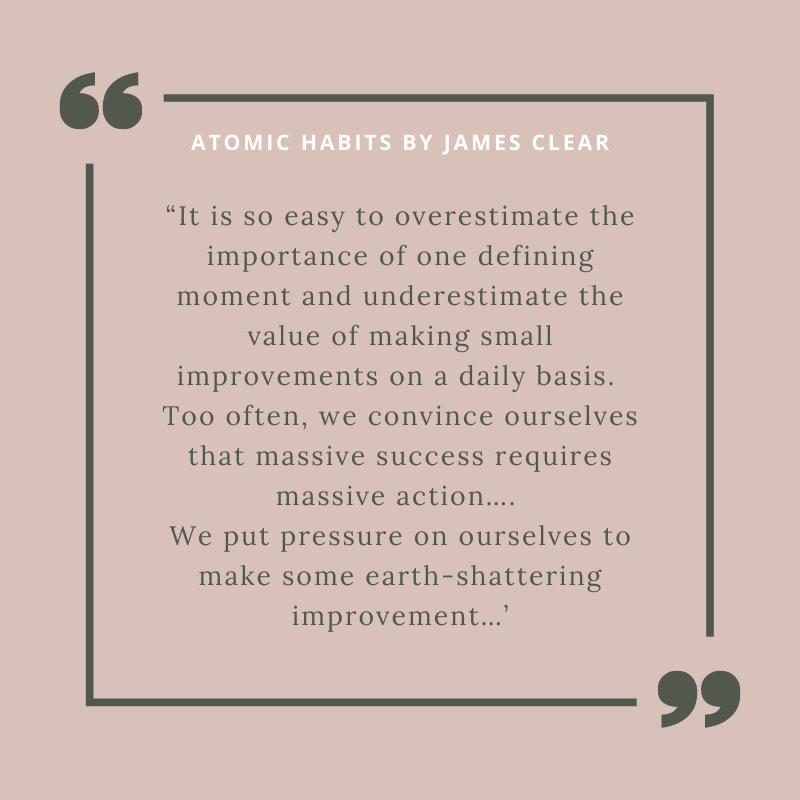
At the beginning of the book, Clear talks about improvements in the British Cycling team. Up until 2003, the British Cycling team had been completely mediocre and had won just one Olympic medal in the Olympics since 1908. Then in 2003 a new director was hired who started implementing a system of teeny tiny changes, with the aim to improve things by 1%
For many of us, getting 1% better everyday might not feel like much. It may even feel like a failure. But if you can improve everything by 1% everyday then you’re going to start seeing big results.
The tiny changes were so small, such as improving hand hygiene to avoid the spread of viruses that could affect the athlete’s training, or even giving them new pillows so they slept better! And slowly, slowly, slowly…it all added up. In 2008, the British Cycling team won 60% of the gold medals available at the Olympics in Beijing!
Why are habits so important?
“Success is a product of daily habits – not once-in-a-lifetime transformations.”
The reason habits are so important is because it means we start doing something automatically, or as close to automatic as possible.
Wouldn’t it be nice to exercise automatically, without spending an hour working yourself up to do it and overthinking it!
Wouldn’t it be nice to automatically eat healthy food without being on a diet.
Wouldn’t it be nice for good habits to come as easily as it is to slump down on the sofa in the evening with a packet of biscuits and a bottle of wine!
The more we can do without thinking, the more space we have in our heads for the important stuff.
I’ve tried to diet in the past and I know how much headspace a diet can take up. It can consume all of your thoughts as you ponder each decision about what to eat and when to eat it. It’s exhausting!
But when eating healthily just becomes a natural habit you end up with so much extra headspace.
Headspace is a topic that I don’t think is discussed enough. We all have lots of tiny things going on in our heads taking up headspace and habits help us clear a bit of headspace so we’re free to think about other things.
“Habits reduce cognitive load and free up mental capacity, so you can allocate your attention to other tasks.”
James Clear, Atomic Habits
Don’t habits make life boring?
I’ll admit that I was one of the people who always thought that habits and routines would make life a bit boring. Doing the same thing every single day? Yawn!
But actually having a set of routines actually gives you more freedom for creativity and spontaneity.
“Habits do not restrict freedom, they create it. In fact, the people who don’t have their habits handled are often the ones with the least amount of freedom.”
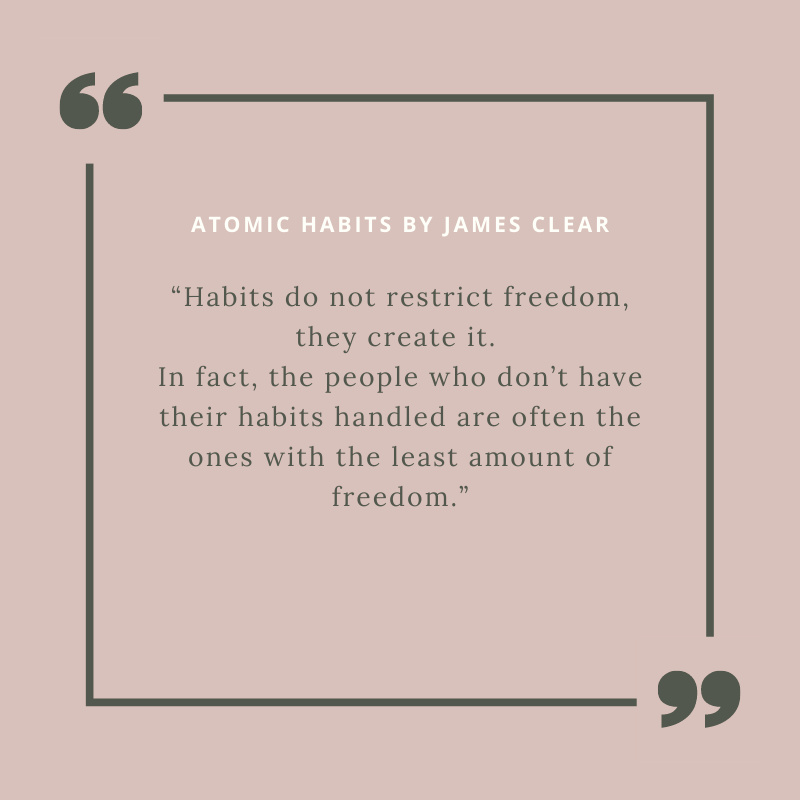
I can fully vouch for this!
Since reading the book I’ve developed a really productive morning routine which means I get lots of jobs out of the way first thing. It means I’ve done everything I need to do early in the day and I have each evening free.
Don’t focus on the goal, focus on the system
At the start of the book, Clear talks about why it’s better to think about the systems rather than the goal.
Let’s say it’s your goal to run a marathon. You’ve booked a marathon in 6 months time because the marathon will encourage/scare you into training. But this goal shouldn’t be the thing that motivates you because once you’ve reached this goal then you’ll probably stop training.
“Achieving a goal only changes your life for the moment.”
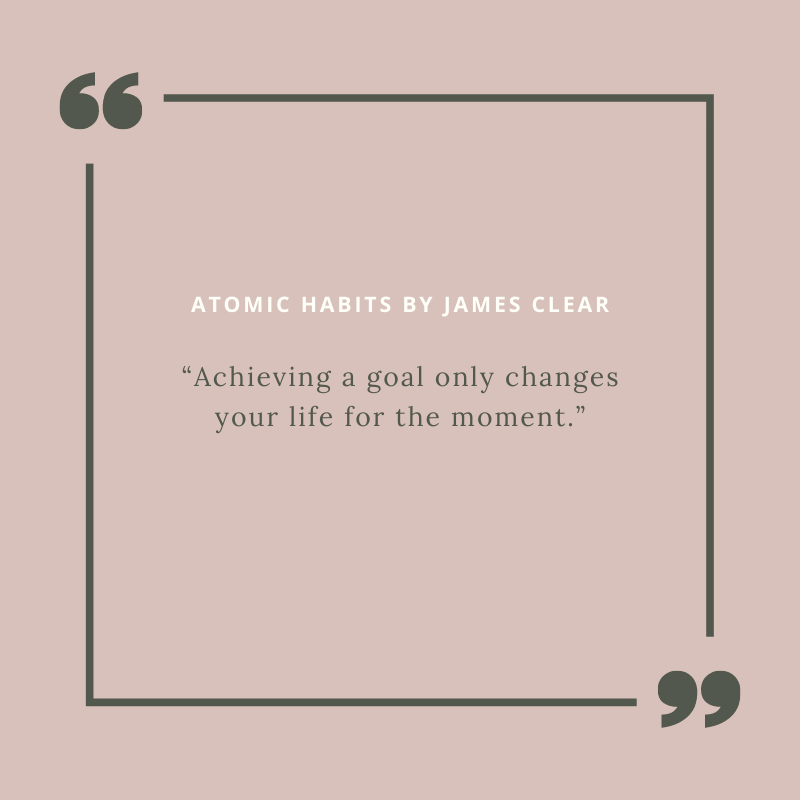
Whereas if you focus on the system of becoming a runner then that is something you’ll do every day. You are a runner and you’ll become a runner for the rest of your life. You’ll enjoy being a runner and you might not run a marathon every month but, in the long run, you’ll probably do a lot more running!
“The implicit assumption behind any goal is this: “Once I reach my goal, then I’ll be happy. The problem with goals-first mentality is that you’re continually putting happiness off until the next milestone…..
When you fall in love with the process rather than the product, you don’t have to wait to give yourself permission to be happy.”
If you focus on ‘the system’ it becomes a long term way of thinking. This system is about continually making progress rather than just reaching one specific goal.
The habit needs to become part of your identity
I found this section of the book really interesting because it’s not something I’d ever thought about before.
Let’s use the goal of running a marathon again, I know it’s a simplified one but it’s something everyone can relate to or adapt to their own goal.
Rather than having a goal to run a marathon, you should have the goal to ‘become a runner’. You want to become the kind of person who runs everyday. You are a runner. You dress like a runner. You eat like a runner. You sleep like a runner. Being a runner is a part of who you are. You friends know you as a runner. You’re part of running clubs. You read running magazines. You listen to running podcasts.
You’re not running a one-off marathon. You are a runner.
“It’s one thing to say I’m the type of person who wants this. It’s a very different thing to say I’m the type of person who is this.”
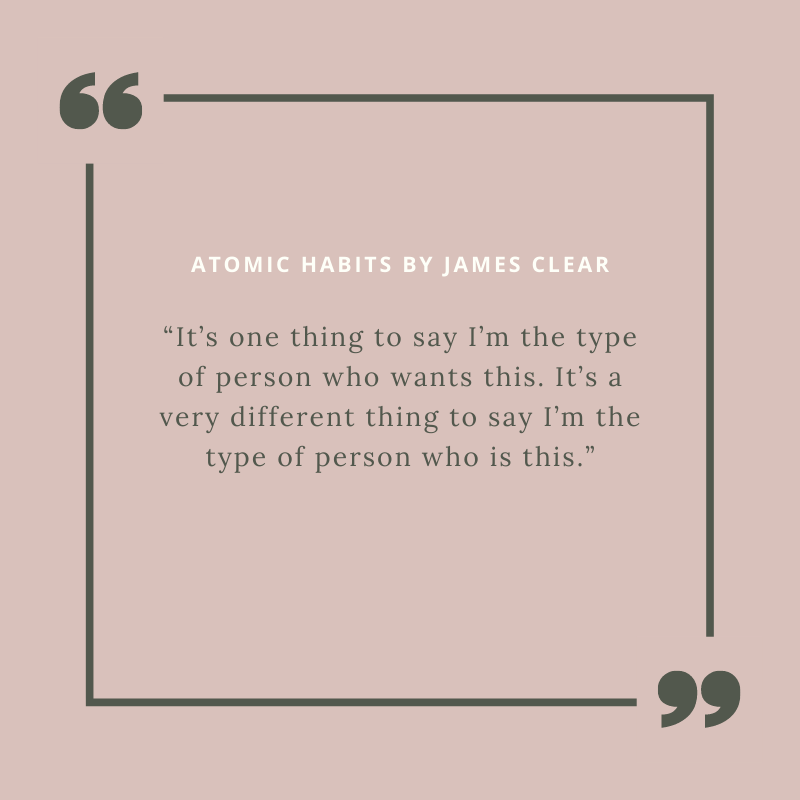
You need to have pride in every aspect of your identity and truly believe it yourself.
But it should be noted that it isn’t easy to change a part of your identity. We often don’t even realise what parts of our identities we cling on to and it really isn’t easy to add new things.
This is something I’ve had to overcome myself recently as I’ve started exercising daily. It took me a while to get into it but I’ve done a 30 minute workout almost every day now since the start of the year!
When I started to realise that my friends and family were noticing and identified me as the type of person who exercised then I started to believe it myself and it’s become a strong part of my identity.
Exercising hasn’t been part of my identity for a long time, but it was when I was younger. I was a sporty kid and regularly exercised until I had children. I stopped for a few years while my kids were really little but this was once a part of my identity so maybe that’s why I found it easier to pick it up again.
“We do not change by snapping our fingers and deciding to be someone entirely new. We change bit by bit, day by day, habit by habit. We are continually undergoing microevolution of the self.”
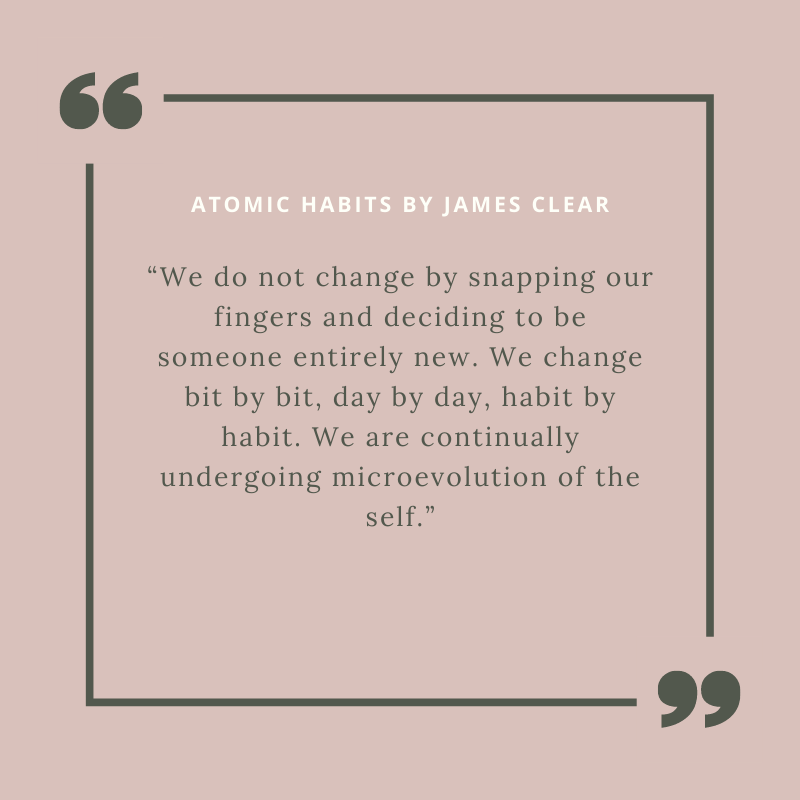
The simplest way to change who you are is to change what you do.
Which makes it sound simple. But it isn’t!
You need to change what you do and keep doing it and proving to yourself and everyone around you that you are this type of person.
There is also an element of ‘fake it till you make it’.
That’s not a phrase that Clear uses but he does discuss a lady who wanted to lose weight and continually asked herself, ‘What would a healthy person do?’ She asked herself this for so long that she eventually became a healthy person!
I think this is another thing that isn’t discussed enough. Most people are just winging it and don’t really know what they’re doing. But you keep winging it and winging it and winging it until one day you realise you know what you’re doing!
The four laws to create good habits
By now you might be thinking about the kind of habits you want to create and the kind of person you want to become. But how do you actually create a new habit!?
According to Clear, there are 4 laws to create good habits.
- Make it obvious
- Make it attractive
- Make it easy
- Make it satisfying
And if you want to break bad habits then you need to do the opposite.
- Make it invisible
- Make it unattractive
- Make it difficult
- Make it unsatisfying
The 1st Law: Make it obvious
“Many of our failures in performance are largely attributable to a lack of self-awareness.’
How many times have you seen someone who is on a diet absent-mindedly snacking at the cookie jar or taking a second helping of cake?
We do so much on autopilot that we often don’t realise what our habits are. If we want to change our behaviour, we need to become aware of our behaviour.
Clear suggests using a process called Pointing and Calling which essentially involves verbally acknowledging habits.
If you’re about to eat a cookie when trying to lose weight, you should say out loud, ‘I’m about to eat a cookie. I don’t need this cookie.’
If I’m totally honest, I don’t really like this part BUT I do think it will help with the next part when it comes to habit stacking (more on that below).
Make yourself an obvious plan
If you want to start a new habit, you need to make yourself a plan. But your plan needs to be specific. It can’t be wishy washy and vague or there are too many loop holes and uncertainties.
My plan was to start exercising every morning but I quickly realised I needed to get super specific with it.
Most people’s plans will depend largely on time and location.
My plan went from:
Exercise everyday
To
Exercise for 30 minutes every day at 7.30am. I will begin the moment Sam leaves for work each morning at 7.30. I will make sure I am dressed and ready to workout by 7.15am and I will have a strong coffee. I will plan my morning workout the evening before. I will sort the kids out with breakfast at 7.20am to ensure they are happy and don’t interrupt my workout.’
As you can see, my workout plan is very obvious and there is absolutely no room to manoeuvre AT ALL!
There is one quote from the book that made my heart sing:
“Many people think they lack motivation but what they really lack is clarity.”
This was me!
For years I didn’t understand why I couldn’t find the motivation to do this. I thought I was weak. I thought other people were better than me.
But when I made the rules for my new habit SO obvious, I found I could suddenly stick to it.
I can follow rules, even if they’re rules I’ve set for myself. But the rules need to be obvious otherwise there is too much bendy space and room to manoeuvre.
Starting a new habit with a young family
Not only does my new habit need to be obvious for me but it needs to be obvious for my whole family.
Anyone with young children knows how much everyone depends on you. The second you sit down you can guarantee someone needs some help to do something!
Exercising with three young children at home was never easy but I’ve found it much easier now that my routine is very obvious. My whole family know exactly when, where and for how long I’ll be exercising. They know they can’t interrupt me and they also know it doesn’t last long so they can wait until I’m finished.
I’ve also found that my new routine has helped with their routines too.
I’m basically ushering Sam out of the door at 7.30am so I can crack on with my workout, so he’s never late for work. My kids know they have to eat their breakfast while I’m exercising and they have to brush their teeth and get dressed by the time I’m finished. So they also know that when I’m finished it’s time to walk to school, so it really helps with our whole morning routine!
Habit stacking
As you can see from my new habits and routine above, one habit can nicely lead to another.
Habit stacking is where you take one established habit and tack a new habit onto it.
Most of us do something like this already:
- Get up
- Use the bathroom
- Brush your teeth
- Let your dog out
- Have a drink
- Put the news on
Let’s say you wanted to eat more fruit, you could add ‘Grab an apple’ in between having a drink and putting the news on so it then becomes a habit to sit down and eat an apple while watching the news.
You can see that my habit to workout on the morning begins when Sam leaves for work.
‘When Sam leaves for work at 7.30am, I will start exercising.’
In order for habit stacking to work, you really need to start with the perfect cue. The cue has to be dependable and solid and very much established for this to work. The cue must be very specific and easily actionable.
It’s probably best to not have a cue that relies on someone else. In my case it works because Sam goes to work every weekday and he’s rarely late, but if you live with someone who works shifts or leaves at various times each day then it’s probably not going to work. I also feel that when Sam leaves for work, the atmosphere in the house changes. We go from being sleepy and cosy and warm to being like, ‘Right, let’s get dressed and get on with the day!’
Environment is more important than motivation
This was another chapter I was so happy to read. I felt like a total failure when I couldn’t find the motivation to exercise, but realising that environment is actually much more important than motivation was a game-changer!
If your environment is filled with positive cues then you’re much more likely to succeed.
And what’s even better is the fact that we have so much control over our environments.
I’ll say that again. YOU HAVE CONTROL OVER YOUR ENVIRONMENT.
“Environment design allows you to take back control and become the architect of your life. Be the designer of your world and not merely the consumer of it.”
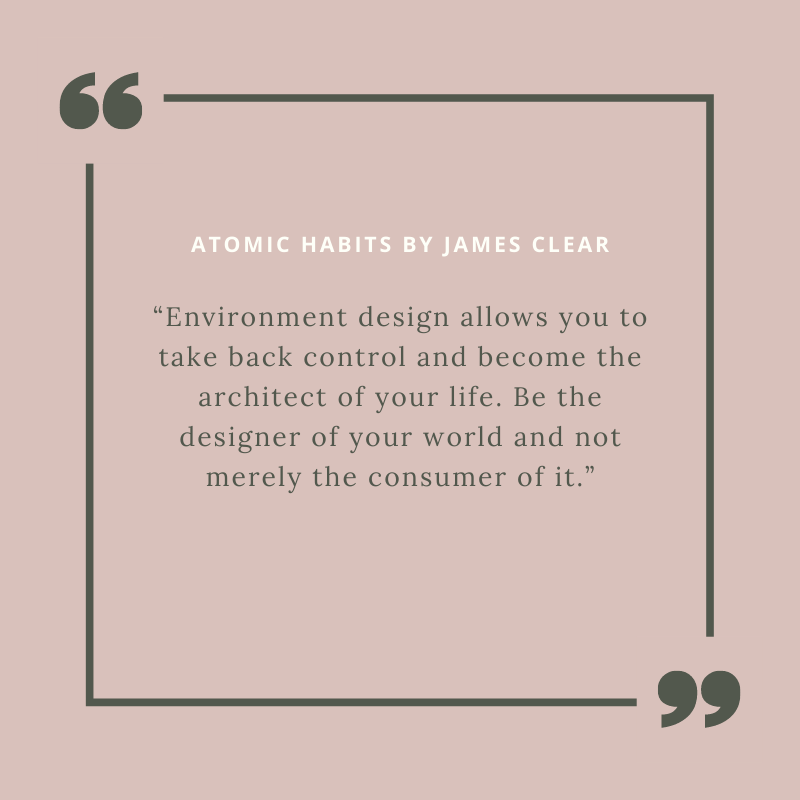
If you’re going out for lunch with your friends and you’re trying to be healthy, tell your friends you want to eat at a specific restaurant where you know there’s a healthy menu.
If you want to read more books and watch less TV, cancel your Netflix subscription and fill your shelves with books!
Making cues visible
Another really important thing to start a new habit is to ensure that the cues are visible.
A big environmental change I made to help me exercise more was to bring all of our exercise equipment into the house. We used to keep it outside in the summer house where it was easy to ignore, but it’s hard to ignore an exercise bike when it’s sat behind your desk or a yoga mat when it’s laid out on your bedroom floor!
I even notice that if I roll my yoga mat up and put it under my bed, I use it less often in comparison to when I leave it rolled out!
“Whenever possible, avoid mixing the context of one habit and another. When you start mixing contexts, you’ll start mixing habits – and the easier ones will usually win out.”
I thought this was interesting and so true. If your plan is to read more, then avoid aiming to read your books on the sofa where you’d normally sit and watch TV. It’s just too easy to sit down and automatically put the TV on.
Motivation is overrated – environment often matters more
This was an interesting section in the book looking at research around ‘people with self control’. It’s more likely that people who appear to have more self control, are actually just better at controlling their environment and avoiding situations where they’d need to use their self control.
I do this myself with food.
When I do my online food shop I’m pretty good about only selecting healthy food. So when I’m at home, I only have the option to eat healthy food.
And the main reason for this is because when I have unhealthy food in the house I eat it all!
I don’t buy alcohol or chocolate mid-week because Sam and I just eat and drink it all.
It’s not that we’re super healthy or have lots of self-control, it’s that we don’t have any in the house.
The 2nd Law of Atomic Habits: Make it attractive
The 2nd law in the book is all about how to make a habit irresistible and Clear begins by looking at what causes a dopamine spike in the brain. We are animals after all and many of our decisions are driven by neurological processes.
A dopamine spike is a pleasurable experience so it’s something we want to replicate! An experience can lead to a spike in dopamine but the anticipation of that experience can too. Studies have found that cocaine addicts actually get a spike of dopamine when they see the drugs, not when they take it. And we obviously don’t want to become cocaine addicts but we want to be at a stage where we get a surge of dopamine before we perform our new habit as this spike will give us a surge of motivation to get it done.
I feel this already with exercising. I get a little surge of excitement as I start putting my workout clothes on!
But how do you make a habit irresistible?
The first trick to making a habit irresistible lies in ‘temptation bundling’ which can be really effective if you’re trying to build a habit that is less than desirable!
It’s a little bit like habit stacking but you take a pleasurable habit you already have and stack a new habit onto it. If you can’t do the two habits at the same time then it’s best to do the new habit before the pleasurable habit so you get a reward after it. Eventually you’ll start to associate the new habit with a reward (and possibly a dopamine spike).
A popular example is working hard at your computer for 20 minutes and then giving yourself a 5 minute break to check social media.
An example Clear gives in the book is a guy who watched Netflix while riding his exercise bike. He’d rigged the bike so that when he rode too slowly, the TV would shut off so he had to continue pedalling quickly to do the thing he enjoyed.
How can family and friends help change your habits?
Our family and friends can have a huge influence on our habits.
“One of the deepest human desires is to belong. And this ancient preference exerts a powerful influence on our modern behaviour.”
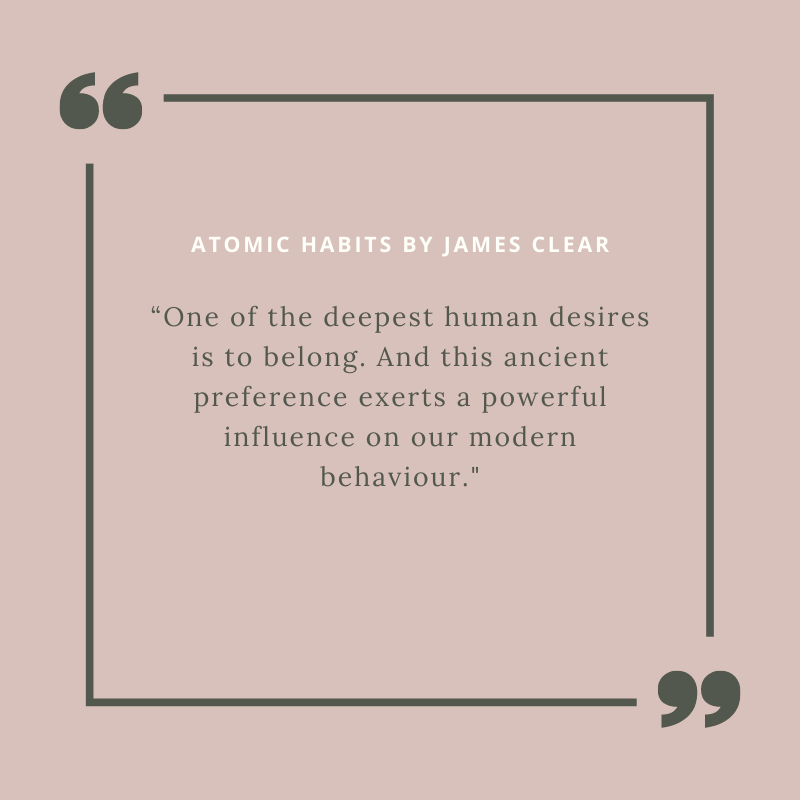
I really love this section of the book because it highlights the importance of surrounding yourself with people who have similar goals to yourself. As humans, all we really want to do is fit in so it’s all about finding a group of people with habits you want to fit in with.
And what’s even better is that it’s so easy to join online communities and surround yourself with these people.
I’m part of a Facebook group filled with mums who want to get fit and healthy and I can’t tell you how motivating it is. It’s not just for mums but there are lots of mums in the group who are regularly sharing their progress and workout routines and it really inspires me and reminds me that daily workouts are the norm for so many people.
Whenever possible, it’s definitely better to join a ‘real life’ group but I think online groups are a lovely introduction to something that’s new and a bit scary.
When I first started ‘properly blogging’, all of my closest friends were bloggers. I worked at Flight Centre in the social media and content team with Vicky Flip Flop, Jayne from Girl Tweets World and Macca from An Adventurous World and it’s no coincidence that we all went on to be full time bloggers and content creators! We would eat, sleep and breathe travel content. We would regularly attend events together, take trips together, spend our lunch breaks talking about blogging, and spend our coffee breaks planning blogging ventures. For those few years, our lives revolved around blogging and we all encouraged each other to do more and try harder.
If I hadn’t surrounded myself with those like minded people during my early years of blogging, I’m almost certain I wouldn’t still be blogging now.
Why it’s important to develop good habits for our children
“We don’t choose our earliest habits, we imitate them.”
James Clear, Atomic Habits
This quote is from the book but there is actually no mention by Clear about the importance of developing good habits for the benefit of our children, this is just something I picked up on.
If the majority of our habits are imitated, I feel that it’s so important to set our children up with good habits from the very beginning.
Habits like eating healthily, exercising, spending time outdoors, not spending too much time on social media, avoiding too much screen time, putting aside time to be creative and time for learning are all so important. And if we can make sure these are just natural habits for our children then we’ve set them off on a good path!
Many of the good habits I’m trying to adopt are for my immediate benefit. But one of the long term benefits will be that these are habits my children will hopefully imitate when they get older.
Bad habits and human nature
One important part of the book examines why we originally develop bad habits. It’s important to realise that bad habits are usually a result of human nature and the primitive instincts we have to stay alive and thrive.
Many of our cravings come from basic desires to conserve energy, fit in with the tribe and reproduce.
My desire to eat chocolate on the sofa and watch Netflix all evening with Sam is just a cavewoman instinct!
“Your habits are modern day solutions to ancient desires.”
Sometimes you just need a slight mind-set shift to reframe these desires and turn them into more desirable habits. (Although there is nothing wrong with spending my evenings watching Netflix on the sofa!)
The 3rd Law: Make it easy
“The idea behind make it easy is not to only do easy things. The idea is to make it as easy as possible in the moment to do things that pay off in the long run.”
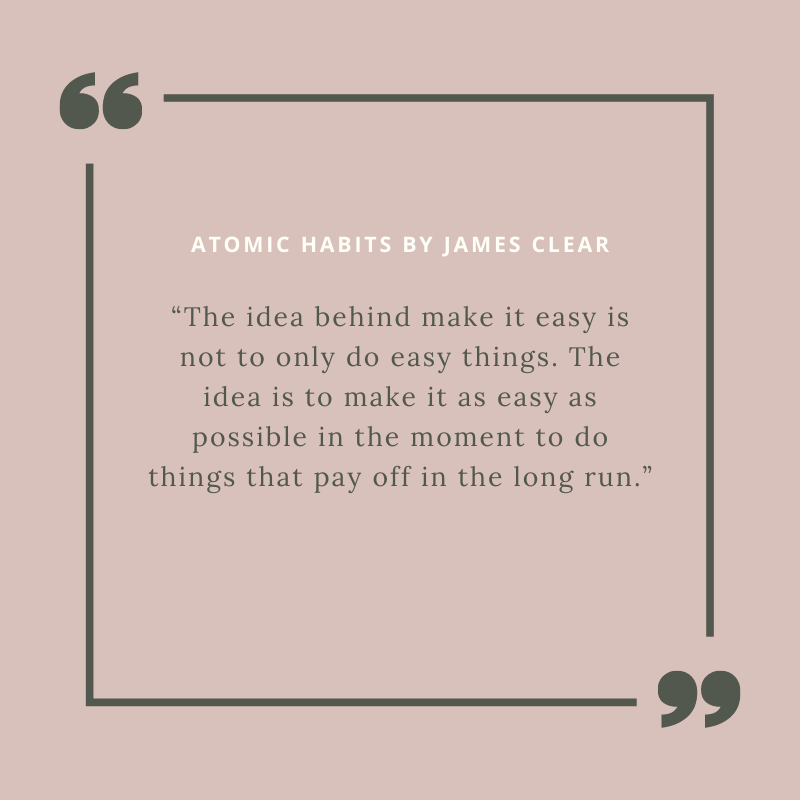
“Habits are easier to build when they fit into the flow of your life. You are more likely to go to the gym if it is on your way to work because stopping doesn’t add much friction to your lifestyle.”
This isn’t mentioned in the book but if you’re struggling to develop a new habit, sit down and write a list of all the things that are making it hard to adopt. And then think of ways to overcome each of these obstacles that make it difficult.
If you want to read more but you’re too tired in the evening then you need to find a way to overcome this, such as:
- Read first thing in the morning
- Go to bed earlier so you’re not as tired
- Switch to audiobooks so they require less effort
- Read more interesting books that don’t send you to sleep!
- Switch up your routine so you can read earlier in the day
When you think of practical solutions you often realise that you’re just making excuses!
For me, I wanted to exercise in the morning but I just didn’t have the energy to get up any earlier. So I asked myself how to overcome this. Eventually I realised I didn’t need to get up earlier, I just needed to do my normal morning jobs the evening before so my mornings were then freed up for exercise.
The two-minute rule
One thing I really love in the book is the mention of the two-minute rule. This rule states that any new habit should initially only take two minutes.
And I know what you’re thinking. ‘You can’t do anything in two minutes!’
This is true but the first two minutes are often the hardest so just getting into the routine of starting a new habit can help it fully develop.
Clear refers to this as a ‘gateway habit’. It’s the first part of a habit before the actual hard bit begins.
For me, my gateway habit to exercising in the morning is putting on my workout clothes and having a coffee. I have to do this before I begin and just getting into the routine of doing this each morning naturally leads to me actually exercising.
And this enjoyable gateway habit leads nicely to the fourth law.
The 4th Law: Make it satisfying
Like I said, my gateway habit to exercising is putting on workout clothes and having a coffee and, for me, this is really satisfying.
I’ve invested in really lovely workout clothes. Buttery soft leggings and vibrant tops that make me feel good so I love putting them on in the morning.
And then I have a coffee which, once again, I love because I love good coffee. Sam and I really enjoy choosing our coffees each month and I enjoy making it and drinking it quietly in the kitchen.
This part of my morning routine is satisfying in so many ways.
“But there is a trick. We are not looking for just any type of satisfaction. We are looking for immediate satisfaction.”

Clear talks about the difference between immediate and delayed rewards. Unfortunately, many of the good habits we try to adopt have delayed rewards. It could be losing weight, getting fit or learning something new. For most of us it’s going to take a couple of months before we start seeing the benefits of our hard work. Without instant satisfaction it can be really hard to keep up with new habits so we need to find alternative ways to make it instantly satisfying.
If the actual habit isn’t satisfying itself then do things before and afterwards that are enjoyable. For me, it’s having a nice coffee just moments before I begin and wearing nice workout clothes. Then as soon as I’m finished I jump in the shower for a long, hot soak with nice bubbles and soaps and lotions and potions!
I don’t always enjoy working out but I do enjoy my routines before and afterwards.
Motion Vs Action
There’s an interesting section in Atomic Habits around Motion vs Action.
Motion is where we start making a plan. Action is where we actually do the thing.
Motion is important but don’t convince yourself you’re making progress because you’re creating motion. Motion is often a form of procrastination.
I’m sure we all remember the days of being students and making ‘revision plans’. I’d spend longer on my revision plan than I would doing any revision. It would be colour coded with fancy highlights and every moment perfectly planned out.
It would make me feel like I’d begun revising, without actually doing any work at all!
Don’t kid yourself into thinking you’re making progress with a plan. You need to take action on your plan!
How to stop your bad habits
There is so much in the book about stopping bad habits and it’s basically just an inversion of all the rules.
- Make it invisible
- Make it unattractive
- Make it difficult
- Make it unsatisfying
It’s all about making bad habits impossible or just so difficult and unappealing you don’t want to do them/can’t be bothered!
Using our genes to our advantage
There is a whole section in the book about trying to adopt habits that come naturally to us. People often don’t like to admit that our genes can play a huge role in our lives and often determine what we can and can’t do. Don’t fight it, just go with it.
We’re often fed the line that we can do anything and be anyone we want to be. Buuuuut, that’s not really true is it?
Focus on what you’re good at and what comes naturally to you.
If you want to get fit but you hate running then don’t even try to become a runner. Try a dance class or take up yoga. I’d love to run but it kills my knees, hips and shins. I’m in agony after every run so I quickly realised it wasn’t the sport for me!
The Goldilocks rule to stay motivated
Have you heard of the Goldilocks Rule? It’s a simple rule that states things should be just the right level of difficulty to keep you motivated. If something is too easy then we become bored. If it’s too hard then we lose motivation and give up.
Our habits need to be ‘just right’ in terms of difficulty.
We need to continually adjust our habits to ensure they remain on the right side of difficult and that’s why monitoring and tracking our habits is important.
And this is a good way to stop our bad habits too. If we make our bad habits difficult to perform then we will eventually stop doing them!
Is there a downside to creating good habits?
I’m sure we can all agree that there isn’t really a downside to having good habits but Clear does warn that when we start performing habits on autopilot, we can start making mistakes.
It’s definitely not a reason to avoid making good habits, it’s just something to be aware of.
This is why it’s really important to track our habits with things like journals, reports, reviews, photos or good old fashioned spreadsheets with stats!
One important thing to remember is that habit tracking shouldn’t be a timely chore. If possible, habit tracking should be automated or very simple otherwise you’re going to have to adopt a whole new habit to track the original habit you wanted to begin!
As someone who likes documenting things, I wish there was more information in the book about how other people track their habits. I’d happily read a whole new book about this!
I don’t want to keep going on about my Peloton bike but it is really good for tracking fitness progress. You get an overall score for each ride and I love seeing my scores gradually increasing over the weeks and months. I can actually see myself getting fitter and that’s really motivating!
Final summary and review of Atomic Habits
I think readers of Atomic Habits will get more from the book if you already have a specific habit you want to develop. The first time I listened to the book I didn’t have a specific goal in mind. I knew I wanted to change something in my life, but I didn’t know what the thing was.
I found the book interesting and took away some valuable tips but I didn’t immediately have a plan of action.
The second time I listened to the book was a few months later when I knew I wanted to get into the habit of exercising in the morning. And this time the book felt very different! I felt like James Clear was speaking directly to me with specific advice that I could easily follow. I could picture myself adopting these new habits and could imagine how I would implement each step.
And then when I read the book for the third time, that’s when I realised that I had actually used so much of this advice!
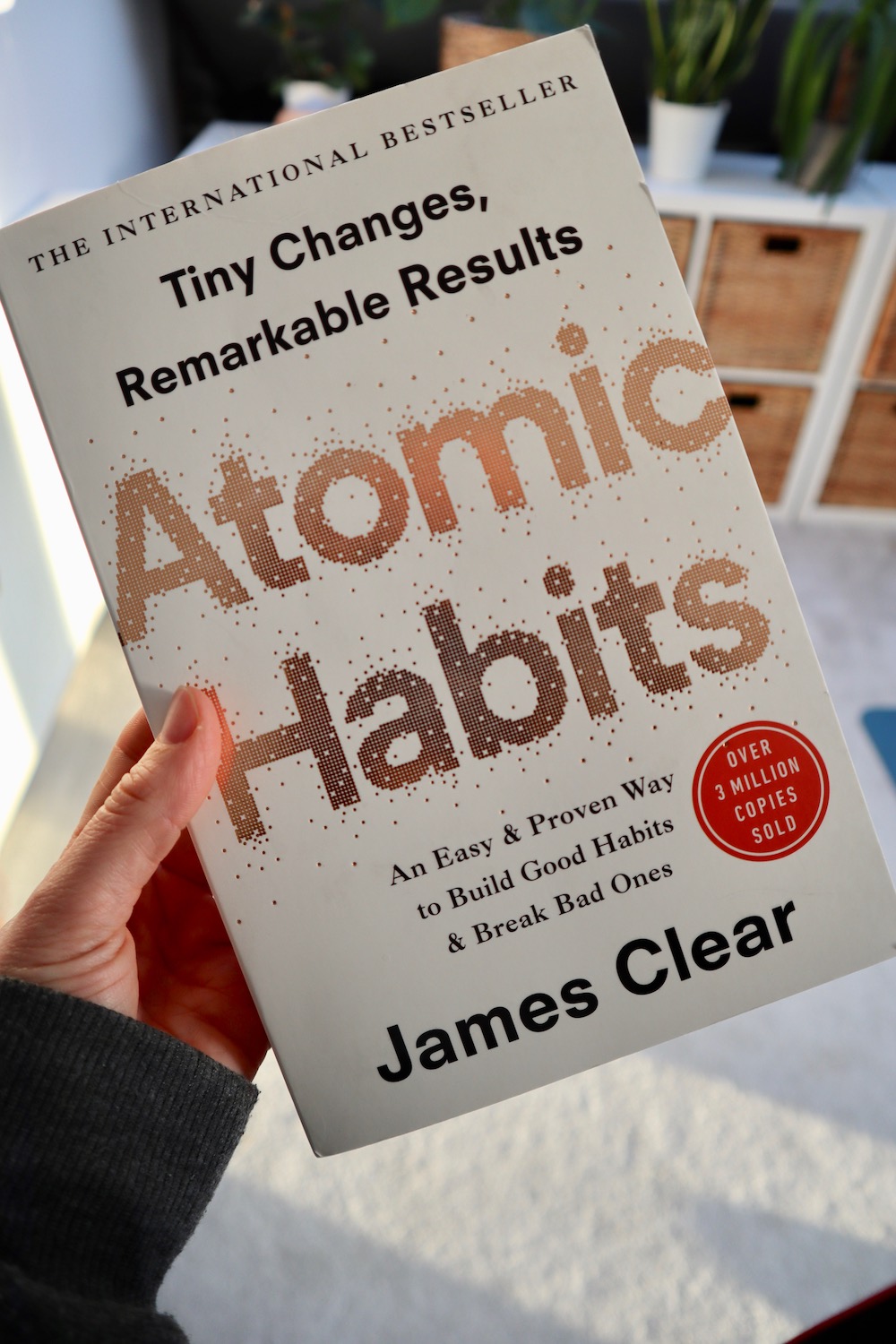






? I really liked this summary — especially the focus on identity-based habits and making systems obvious, easy, and rewarding. When I first read Atomic Habits, I nodded along to everything, but applying it was hit-or-miss. Discovering Archetype6 helped me understand why: I’m an Activator, so I tend to start fast but burn out or jump to the next thing before anything sticks.
Here’s what shifted once I knew that:
1. I learned to build just enough structure to keep moving — not so much that it slows me down.
2. Wins have to feel immediate or I’ll lose interest, even if the long-term goal matters.
3. Swapping stories with other Activators gave me better tools than trying to follow one rigid method.
One thing I’m still figuring out: how do you keep momentum going once the “newness” of a habit wears off?